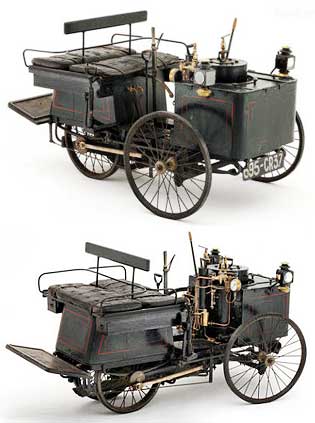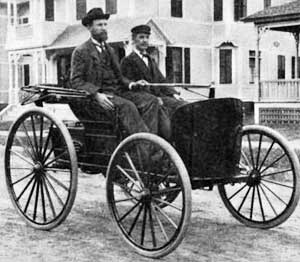First
Racecar
Human nature being what it is, the first racecar in history appeared
very shortly after the first gasoline powered cars were invented.
In 1885, Gottlieb Daimler invented the precursor of what was to
be the modern car engine. He first used it in a two-wheeled vehicle
and the following year built the first four-wheeled gas fueled
vehicle in the world. In 1886, the first patent for a gasoline
fueled car was granted to Karl Benz. Of course, once there were
cars, there had to be a way to prove which was the best and what
better way than to let the contenders fight it out in a race?
|
|
 First Race Car the de Dion-Bouton
First Race Car the de Dion-Bouton
|
Thus it was, that in 1887, the editor in chief of a small Paris
magazine, dedicated to human powered vehicles (in other words
bicycles) announced a car race to be held over a distance of about
a mile and a quarter, between the bridge at Neuilly-sur-Seine
and the Bois de Boulogne. This race is usually given the much
grander title of the Paris-Versailles race but that doesn't alter
the fact that it was just a short walk from start to finish.
The first racecar in history turned up on the appointed day,
April 28th 1887 that had been organized by Monsieur Fossier. The
editor in chief of "Le Velocipede" had extended an open
invitation to all comers to enter. A car manufactured by the partnership
of engineer Georges Bouton (1847-1938) and enthusiast Count Jules-Albert
de Dion (1856-1946) turned up at the appointed hour on the start
line. Driven by Bouton, the de Dion-Bouton automobile company's
car (pictured above) was the only entrant in the race, so, in
horse-racing parlance, it was a walk-over. To Georges' credit,
he crossed the finish line at a breakneck speed of just over 37
miles per hour.
Many consider that the first true race was the one that took
place some seven years later, from Paris to Rouen - a distance
of just under 80 miles. This race was organized by another editor
in chief, M. Pierre Giffard of the newspaper "Le Petit Journal"
- media sponsorship is clearly as old as motorsport itself. Safety
and economy were uppermost in the minds of the organizers and
out of a total of 102 original entries, 69 turned up to a qualifying
event over 50 kilometers that slimmed the field down to 25 finalists.
Once again, first past the post was a De Dion vehicle, this time
with the Count himself behind the wheel. Unfortunately, since
he was driving a steam car that needed the services of a stoker,
he was not declared the winner.
|
That honor went to Georges Lemaitre in
a Peugeot (pictured). Quite how De Dion could get as far
as crossing the finishing line in first place before being
told the rules takes some understanding. The conversation
must have been interesting.
|
 Georges Lemaitre in a Peugeot
Georges Lemaitre in a Peugeot |
The first race in the United States was in 1895 and featured
83 entries but only 7 made it to the starting line. The race was
54 miles round trip between Chicago and Evanston, Illinois. One
electric car couldn't start the race and the other electric car
could only travel 11 miles. Three Benz vehicles started the race
along with a car built by Charles Duryea.
Two motorcycles started the race but dropped out unable to climb
some of the steep grades in the race. This left the gasoline-powered
automobiles to compete. Two Benzes dropped out for various reasons
which left one Benz and the Duryea to finish the race.

Duryea Car |
The Duryea started out fast, then was
passed by the Benz going to Evanston. The Duryea took the
lead on the return trip and finished the race first winning
the $2,000 prize money. The Duryea, then is acknowledged
as the first winning race car in the United States.
|
So, even though the first racecar in history may not have had
the glory that goes with winning a full-blown competitive race,
it is, at least, remembered for its pioneering achievement. The
spirit shown by the magazine's editor in chief, by the engineer
and by the enthusiastic Count De Dion is the same as that seen
today with all involved in NASCAR, Formula 1 and all other motorsport
races. Long may that spirit live on.
Today’s modern race car engines are becoming supercharged, resulting in incredible performance and handling. Boat builders are beginning to apply this technology as well to marine vessels for better speed and fuel efficiency. Many Azimut Yachts for sale on the market today are supercharged just like a race car.
|

